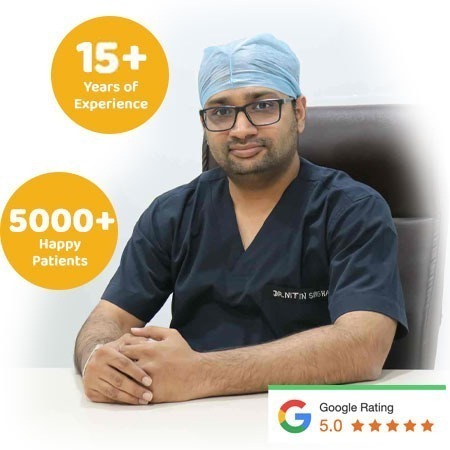
Robotic cancer surgery represents a breakthrough in the field of oncology, combining advanced surgical technology with the skill of experienced cancer surgeons. Unlike traditional open surgery, robotic-assisted procedures are minimally invasive, offering smaller incisions, less blood loss, reduced pain, and faster recovery times. With the support of advanced robotic platforms, surgeons gain a high-definition, magnified 3D view of internal anatomy, allowing them to perform even the most complex cancer operations with unmatched accuracy and control.
In Ahmedabad and Gujarat, leading specialists like Dr. Nitin Singhal have adopted robotic-assisted surgery to treat cancers of the gastrointestinal tract, gynecologic system, thoracic cavity, and urological system. Patients benefit from shorter hospital stays, quicker return to daily activities, and improved oncological outcomes, making robotic cancer surgery one of the most advanced treatment options available in India today.

Da Vinci Robotic Surgical System
At the heart of this innovation is the Da Vinci Robotic Surgical System, a state-of-the-art platform recognized globally as the gold standard in robotic-assisted surgery. The system features highly specialized instruments and advanced 3D visualization, allowing surgeons to replicate natural hand movements with smaller, more flexible instruments that exceed the maneuverability of the human hand. By eliminating tremors and offering enhanced precision, the Da Vinci system ensures safer and more effective procedures, even in delicate and hard-to-reach areas.
In the hands of skilled experts like Dr. Nitin Singhal, a leading robotic oncologist in Ahmedabad, this technology is transforming cancer care. From esophageal and pancreatic cancer surgery to gynecologic and colorectal oncology, robotic systems are making it possible to achieve better surgical outcomes, minimal complications, and faster recovery, providing patients with world-class cancer treatment right here in Gujarat.
Robotic cancer surgery has transformed modern oncology by offering patients safer, less invasive, and more effective treatment options. Compared to traditional open procedures, robotic surgery provides multiple advantages that significantly improve both recovery and long-term outcomes. Key benefits include:
Dr. Nitin Singhal, a leading robotic cancer surgeon in Ahmedabad, combines this advanced technology with over 15 years of surgical oncology expertise to deliver the highest standard of personalized cancer care. Trained at the prestigious Tata Memorial Hospital, Mumbai, he specializes in robotic surgery for gastrointestinal, gynecologic, liver, pancreatic, and esophageal cancers, ensuring that patients across Gujarat and India receive world-class treatment with compassionate support.


The biggest advantages of robotic cancer surgery in India include less blood loss, minimal scarring, shorter hospital stays, and quicker recovery time. It also reduces post-surgery pain and helps patients return to normal activities sooner. Many people searching for the best robotic cancer treatment in Ahmedabad choose it for these patient-friendly outcomes.
The cost of robotic cancer surgery in India depends on the type of cancer, hospital facilities, and the complexity of the procedure. While it may be slightly higher than traditional surgery, patients often find it cost-effective in the long run because of reduced complications, fewer hospital days, and faster return to work
Robotic surgery is ideal for patients with cancers of the prostate, kidney, uterus, stomach, colon, and cervix. A consultation with a top robotic surgeon in Ahmedabad helps decide if you are the right candidate. Factors like overall health, stage of cancer, and treatment goals play a major role in the decision.
Recovery after robotic-assisted cancer surgery is usually much faster compared to open surgery. Most patients can walk within 24 hours and resume daily activities in 2–3 weeks, depending on the type of procedure. This quicker healing makes robotic surgery in India a preferred choice for many cancer patients.
Cancer typically has four stages: I through IV (1 through 4). Some cancers even have a stage 0 (zero). Here’s what these stages mean:
Sometimes, but not always. The signs and symptoms of cancer depend on where the cancer is located and how big it is.
As a cancer grows, it can push on nearby organs and other structures. The resulting pressure can cause signs and symptoms.
Some cancers grow in places where they won’t cause any signs or symptoms until they have advanced. For example, pancreatic cancer usually doesn’t cause any signs or symptoms until it grows large enough to press on other structures, causing pain, or manifesting signs of jaundice, which is yellowing of the skin.
Some general signs and symptoms of cancer can include:
Keep in mind that there can be other reasons for these signs and symptoms. The only way to find out what’s causing them is to see your doctor. If you notice any of these symptoms and they don’t pass, it is time to get them looked at.
Chemotherapy uses drugs to destroy cancer cells. But chemotherapy drugs can also harm healthy cells, leading to treatment side effects.
Newer drugs, called targeted drugs, block genes or proteins found in the cancer cells. Targeted therapy usually causes less harm to healthy cells, but it still has side effects.
Immunotherapy uses hormones and other drugs that work with your immune system to treat cancer.
Recommendations for the types of screening tests and the ages you should get them vary according to cancer type. So, it’s a good idea to have a conversation with your doctor about what type of test you might need and when.
